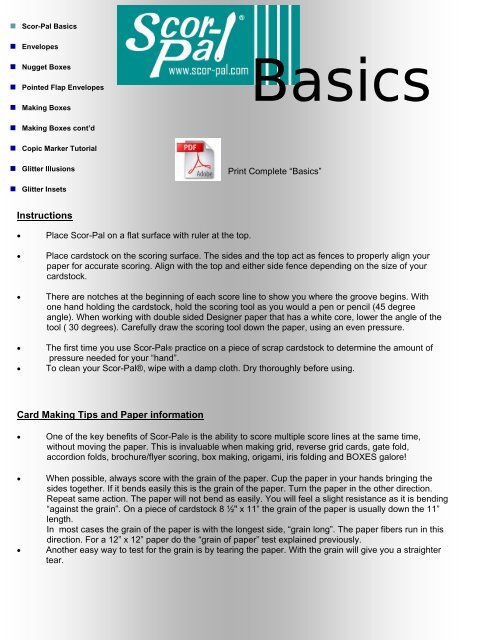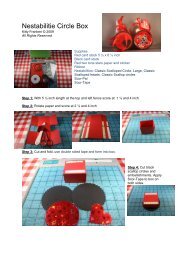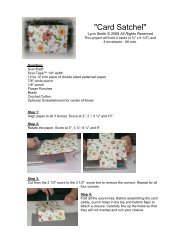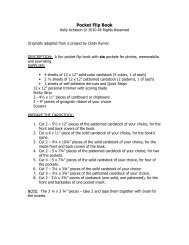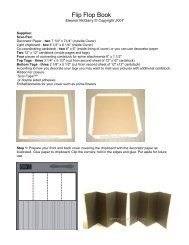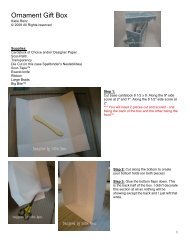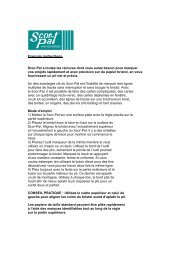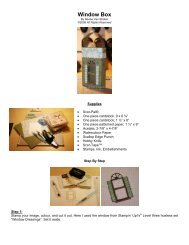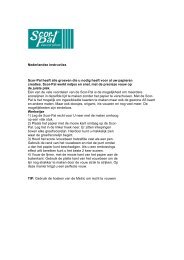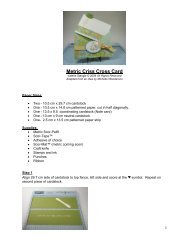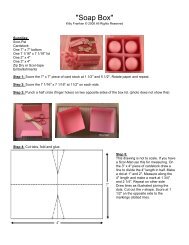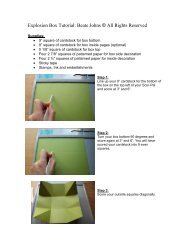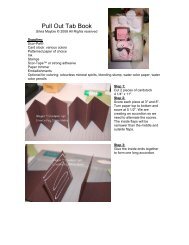Scor-Pal Basics Mar 17 Final copy for upload
Scor-Pal Basics Mar 17 Final copy for upload
Scor-Pal Basics Mar 17 Final copy for upload
Create successful ePaper yourself
Turn your PDF publications into a flip-book with our unique Google optimized e-Paper software.
<strong>Scor</strong>-<strong>Pal</strong> <strong>Basics</strong><br />
Envelopes<br />
Nugget Boxes<br />
Pointed Flap Envelopes<br />
Making Boxes<br />
Making Boxes cont’d<br />
Copic <strong>Mar</strong>ker Tutorial<br />
Glitter Illusions<br />
Glitter Insets<br />
Instructions<br />
• Place <strong>Scor</strong>-<strong>Pal</strong> on a flat surface with ruler at the top.<br />
• Place cardstock on the scoring surface. The sides and the top act as fences to properly align your<br />
paper <strong>for</strong> accurate scoring. Align with the top and either side fence depending on the size of your<br />
cardstock.<br />
• There are notches at the beginning of each score line to show you where the groove begins. With<br />
one hand holding the cardstock, hold the scoring tool as you would a pen or pencil (45 degree<br />
angle). When working with double sided Designer paper that has a white core, lower the angle of the<br />
tool ( 30 degrees). Carefully draw the scoring tool down the paper, using an even pressure.<br />
• The first time you use <strong>Scor</strong>-<strong>Pal</strong>® practice on a piece of scrap cardstock to determine the amount of<br />
pressure needed <strong>for</strong> your “hand”.<br />
• To clean your <strong>Scor</strong>-<strong>Pal</strong>®, wipe with a damp cloth. Dry thoroughly be<strong>for</strong>e using.<br />
Card Making Tips and Paper in<strong>for</strong>mation<br />
<strong>Basics</strong><br />
Print Complete “<strong>Basics</strong>”<br />
• One of the key benefits of <strong>Scor</strong>-<strong>Pal</strong>® is the ability to score multiple score lines at the same time,<br />
without moving the paper. This is invaluable when making grid, reverse grid cards, gate fold,<br />
accordion folds, brochure/flyer scoring, box making, origami, iris folding and BOXES galore!<br />
• When possible, always score with the grain of the paper. Cup the paper in your hands bringing the<br />
sides together. If it bends easily this is the grain of the paper. Turn the paper in the other direction.<br />
Repeat same action. The paper will not bend as easily. You will feel a slight resistance as it is bending<br />
“against the grain”. On a piece of cardstock 8 ½" x 11” the grain of the paper is usually down the 11”<br />
length.<br />
In most cases the grain of the paper is with the longest side, “grain long”. The paper fibers run in this<br />
direction. For a 12” x 12” paper do the “grain of paper” test explained previously.<br />
• Another easy way to test <strong>for</strong> the grain is by tearing the paper. With the grain will give you a straighter<br />
tear.
• It is best to fold your card so that the score line is to the OUTSIDE of the fold. The bump goes<br />
to the inside. This gives a neater appearance to the inside of the fold..<br />
• When you make the score line you are spreading the paper fibres ready <strong>for</strong> the fold. If you fold so the<br />
score line is to the inside you are squashing the fibres you just spread apart. If you check a package<br />
of 3" x 3" folded cards from Stampin Up you will see that the indentation is on the textured side of the<br />
cardstock. This rein<strong>for</strong>ces,you fold so the score line is to the outside of the fold with textured side out.<br />
• When making accordion folds score at intervals, then turn the paper over and score in between the<br />
previous scores i.e. a one inch accordion along an 11” length, score at 1”, 3”, 5”, 7” and 9”. Turn the<br />
paper over, score at 2”, 4”, 6”, 8” and 10”. The indentation is the mountain fold.<br />
• If you are making the standard A2 card, 4 1/4” x 5 1/2”, score the full eleven inch length at 4 1/4” then<br />
cut the cardstock at 5 1/2”. This way you are saving time by only scoring once to make two cards.<br />
.<br />
Brochure Fold - Dividing an eleven inch length into thirds<br />
• To divide an 11” length into thirds use the grooves marked with the inverted triangles<br />
• These are perfect grooves <strong>for</strong> brochure and letter folding or accordion booklets<br />
• The grooves are 3.666” and 7.333” from the left fence.<br />
• Further flatten the edges with the <strong>Scor</strong>-Tool to have the folded paper or cardstock lie flat.<br />
Gate Fold Cards<br />
• Use the grooves marked with a small dot. They are at 2 1/8” and 6 3/8” from the left fence.<br />
Diagonal <strong>Scor</strong>ing<br />
• For diagonal scoring ensure that both corners are aligned to the same groove. The ruler markings<br />
along each side fence will help with scoring a 12” piece of paper on the diagonal. Align the page with<br />
the 6” groove using the side measurements as a reference <strong>for</strong> centering.
Non - Standard <strong>Scor</strong>es<br />
• You are not limited to half inch measurements.<br />
• Eighth inch markings are between 0 -1" and 11½". By aligning the left side of your paper to<br />
eighth inch markings 1/8” and 1/16” etc scores are possible.<br />
• In the diagrams below you will see how to measure <strong>for</strong> 1/8th and 1/16th inch increments.<br />
Eighths Sixteenths<br />
<strong>Scor</strong>-<strong>Pal</strong> produces a score line similar to a letterpress score.<br />
Letterpress scoring<br />
A letterpress is basically the same type of machine used to foil-stamp and emboss. It is a press<br />
that uses pressure to create a pattern. A letterpress operates with a "male" scoring rule, in our<br />
case the <strong>Scor</strong>-Tool, a "female" channel, the groove and the paper in between. When the rule is<br />
pressed into the channel, it raises a ridge on the inside of the fold. The ridge acts as a hinge,<br />
making the paper easier to fold and ensuring a clean, straight, and durable result. A letterpress<br />
score af<strong>for</strong>ds the cleanest and most accurate fold possible. Although you can score in any<br />
direction, it's harder and riskier to go against the grain or across areas with heavy ink coverage.<br />
The need <strong>for</strong> scoring depends on the particular grade, finish and basis weight of your paper.<br />
http://www.wausaupapers.com/Resources/Tips.aspx?TypeID=5&ID=26
<strong>Scor</strong>-<strong>Pal</strong> <strong>Basics</strong><br />
Envelopes<br />
Nugget Boxes<br />
Pointed Flap Envelopes<br />
Making Boxes<br />
Making Boxes cont’d<br />
Copic <strong>Mar</strong>ker Tutorial<br />
Glitter Illusions<br />
Glitter Insets<br />
Customizing your own envelopes<br />
By Lauren Meader © Copyright 2008 All Rights Reserved<br />
Making your own envelopes is often a task most won't attempt <strong>for</strong> many reasons.<br />
When you take the time to make a gorgeous card, doesn't it deserve its own gorgeous wrapper?<br />
With <strong>Scor</strong>-<strong>Pal</strong>, making your own envelopes is now a super easy task.<br />
The <strong>Scor</strong>-<strong>Pal</strong> when paired with these simple key measurements will make the task easy.<br />
My technique <strong>for</strong> these envelopes can be applied to ANY card size card.<br />
Just a few key points you need to remember and you are well on your way!<br />
Envelope Paper Size Formula<br />
1. Measure size of your finished card<br />
2. Length of card plus 1 1/4" = Width of Paper<br />
3. Width of Card x 2 plus 1/2 of the width = Length of paper<br />
For example<br />
1. An A2 card is 51/2" long x 4 1/4” wide<br />
2. 51/2” + 1 1/4 “ = 6 3/4"<br />
3. 4/14 x 2 = 8 1/2" + half of 4¼ which is 2 1/8 is 8 1/2” + 2 1/8 = 10 5/8” round up to 10 3/4”<br />
Paper size is 6 ¾" wide x 10 3/4" long <strong>for</strong> an A2 Card.
<strong>Scor</strong>ing Formula<br />
Card is A2 size as above but this works with any size card<br />
• <strong>Scor</strong>e 1/2" in from each side of paper.<br />
• Subtract 1 1/4" from width, this is the first score line across the width of the paper <strong>for</strong><br />
example<br />
4¼”- 1 ¼” = 3” First score is at 3”<br />
• Second <strong>Scor</strong>e- add card width to first score line plus 1/4” <strong>for</strong> example 3” ( first score) + 4<br />
¼" (card<br />
width) + ¼" = 7 ½” Next score line is at 7 ½”.<br />
<strong>Scor</strong>e at 3” and 7 1/2” with the length of the paper along the top fence <strong>for</strong> A2 card. See below.<br />
Here is an excel file that figures out the size of paper and where to score. This was created by Dina Griff.<br />
Instructions <strong>for</strong> the most popular size, an A2 card<br />
Step 1: Cut paper to measure 6 ¾” wide x 10 ¾" long.<br />
NOTE: Paper is patterned side up <strong>for</strong> scoring. . When using decorator paper it is<br />
important to lower the angle of the <strong>Scor</strong>-Tool. (See <strong>Scor</strong>-<strong>Pal</strong> <strong>Basics</strong>). Fold so the score<br />
line is to the outside of the fold.<br />
Repeat on<br />
opposite edge.<br />
Step 2:<br />
Align paper so the 6 ¾"<br />
width is to the top and right<br />
fence. <strong>Scor</strong>e at 11 ½".<br />
Turn the paper and score<br />
the other side at 11 ½".<br />
Envelope Sizing Tutorial Excel file<br />
3" 7½"<br />
Step 3:<br />
Turn paper so the 10 ¾" length is aligned with the top<br />
and left fence. <strong>Scor</strong>e at 3" and 7 ½".
Wrong side of paper<br />
Step 4: Snip excess from top<br />
and bottom panel as shown in<br />
photo.<br />
Step 6: Add Terrific Tape ( sold in online<br />
store) adhesive to BOTTOM FLAP edge<br />
( red line shown) Bottom flap is smaller than<br />
your side panels so the adhesive will not<br />
show.<br />
Step 5: OPTIONAL use corner rounder to round top<br />
corners of flap closure and envelopes side flaps. Note the<br />
guard has been taken off the punch so you can snip the<br />
side corners. You can also choose to do a scalloped<br />
border <strong>for</strong> the top flap.<br />
Step 7: Fold in side panels, remove<br />
adhesive backing and fold up<br />
bottom panel.
Step 8: Insert card. You may choose to add a removable adhesive<br />
<strong>for</strong> the closure or tie closed with ribbon.<br />
Voilà a gorgeous custom "Envelope"
<strong>Scor</strong>-<strong>Pal</strong> <strong>Basics</strong><br />
Envelopes<br />
Nugget Boxes<br />
Pointed Flap Envelopes<br />
Making Boxes<br />
Making Boxes cont’d<br />
Copic <strong>Mar</strong>ker Tutorial<br />
Glitter Illusions<br />
Glitter Insets<br />
Tutorial by Diana Crick © 2008<br />
All Rights Reserved<br />
REMEMBER: Square envelopes are non-standard and require extra postage.<br />
Our common letter and cardstock size is 8 1/2” x 11”.<br />
For countries using metric sizing it is called A4 paper and is 210 mm x 297 mm, 8.27” x 11.69”<br />
This is a chart <strong>for</strong> pointed flap envelopes. In my opinion they are not as pretty or practical as the fold<br />
down wide flap in our previous tutorial but this way you can make the choice. Larger size envelope<br />
tutorials will appear in upcoming Ezines.<br />
Finished Card Size Paper Size <strong>Scor</strong>ing Measurements<br />
For cards smaller than 4” square there is<br />
far too much overlap and wasted paper.<br />
Use the size table on the previous page.<br />
4” x 4” 7” Square Align points at 5 3/4”, halfway<br />
between 6 1/2” and 7”. <strong>Scor</strong>e at<br />
3 1/2” and 8”. Repeat <strong>for</strong> other<br />
side<br />
A2 Card - 4 1/4” x 5 1/2” 8 1/4” Square Align points with 6” groove.<br />
<strong>Scor</strong>e at 3” and 9”. Rotate paper<br />
to other points. <strong>Scor</strong>e at the first<br />
inverted triangle and 8 1/2”.
Step One: Paper size is 8 1/4"square.<br />
Align top point at 6” score line. Ensure<br />
bottom point is also in the same groove.<br />
<strong>Scor</strong>e at 3” and 9.”<br />
“Envelobox” <strong>for</strong> A2 Card<br />
Perfect <strong>for</strong> bulky cards<br />
Valerie Stangle © Copyright 2008 All Rights Reserved<br />
In each step pay attention to the orientation (points) of your paper.<br />
Step Two: Move point to 6 ¼.” Visually<br />
line up between 6” and 6 ½” as there isn’t<br />
a marking at 6 ¼,” and score at 3.”
Step Three:<br />
Move point to 5 ¾.” Visually line up<br />
between 5 ½” and 6” as there isn’t a<br />
marking at 5 ¾,” and score at 9.”<br />
Step Five:<br />
Move point to 6 ¼.” Visually line up<br />
between 6” and 6 ½” as there isn’t a<br />
marking at 6 ¼,” and score at 8 ½” and<br />
11.”<br />
Step Four:<br />
Turn the paper a quarter turn, align top point at<br />
6.” Ensure bottom point is also in the same<br />
groove. <strong>Scor</strong>e at 3 ½”, 3.66 (inverted [upside<br />
down] triangle) and 8 ½.” There are three<br />
scores in all.<br />
Step Six:<br />
The score lines intersect along the outer edges of<br />
the paper. At each intersection, cut out a “v”<br />
shape, cutting to the inner score of the<br />
intersection. Be sure to cut on the outside of the<br />
score lines.
Step Seven:Now, to complete your Envelobox,<br />
carefully fold score lines on one side, you are<br />
<strong>for</strong>ming the edges of the box. Fold the remaining<br />
sides in the same manner. Fold and <strong>for</strong>m box.<br />
Step Eight:<br />
Place <strong>Scor</strong>-Tape on as illustrated.<br />
Glue down the little flap.<br />
Step Nine:<br />
Remove backing and adhere box together. Create<br />
matching cards with the remainder of your patterned<br />
paper. Seal your Envelobox with envelope glue, stickers,<br />
ribbons, etc.<br />
Watch <strong>for</strong> other size “Enveloboxes” in upcoming Ezines.
<strong>Scor</strong>-<strong>Pal</strong> <strong>Basics</strong><br />
Envelopes<br />
Nugget Boxes<br />
Pointed Flap Envelopes<br />
Making Boxes<br />
Making Boxes cont’d<br />
Copic <strong>Mar</strong>ker Tutorial<br />
Glitter Illusions<br />
Glitter Insets<br />
Candy Nugget Boxes Revamped <strong>for</strong> <strong>Scor</strong>-<strong>Pal</strong>®<br />
Our Guest Instructor is Sue Reynolds<br />
© 2008 All Rights Reserved<br />
www.HotPawsCreations.blogspot.com<br />
Sue resides in sunny, Orange County, Cali<strong>for</strong>nia with her 3 adopted<br />
doggie fur babies. Sue has been crafting since she was a child. Her<br />
mother taught her many things about sewing, knitting, crocheting and<br />
cooking. Her father taught her all about woodworking and electronics.<br />
Rubber stamps were beginning to come out with more that just your name.<br />
When Creative Memories and Mrs. Grossman’s stickers first came out,<br />
she was hooked. The dining room table was not <strong>for</strong> eating anymore, it was<br />
<strong>for</strong> the new hobby of scrapbooking. Now, being a lucky lady and retiring<br />
early from working as an Ultrasound Technologist to being able to stay<br />
home with her fur babies has been a crafters dream. She built her own 6<br />
ft. light table to be used <strong>for</strong> fabric cutting and the hope of friends sitting<br />
around it crafting as well. Becoming a Stampin’ Up demonstrator opened<br />
up a whole new world of card making, paper crafting and meeting new<br />
people. Then one day finding the <strong>Scor</strong>-<strong>Pal</strong> mentioned on another crafter’s<br />
blog, her curiosity guided her to this new fun tool. Having the time to work<br />
with paper patterns and modify them to work with the <strong>Scor</strong>-<strong>Pal</strong> is how the<br />
newly revamped “Nugget Box” tutorial came to be. Enjoy and don’t eat all<br />
the chocolate be<strong>for</strong>e you give them away!
Three Candy Box Single Row<br />
4 ½ x 6 in bottom<br />
5 1/8 x 3 ¼ in lid<br />
Four Candy Box Single Row<br />
4 ½ x 7 in bottom<br />
5 1/8 x 4 ¼ in lid<br />
Five Candy Box Single Row<br />
4 ½ x 8 in bottom<br />
5 1/8 x 5 ¼ in lid<br />
Six Candy Box Single Row<br />
4 ½ x 9 in bottom<br />
5 1/8 x 6 ¼ in lid<br />
4 1/4"<br />
5"<br />
Bottom of Nugget Box<br />
Seven Candy Box Single Row<br />
4 ½ x 10 in bottom<br />
5 1/8 x 7 ¼ in lid<br />
Six Candy Box Double Row 3 + 3<br />
5 ¾ x 6 in bottom<br />
8 3/8 x 3¼ in lid<br />
Eight Candy Box Double Row 4 + 4<br />
5 ¾ x 7 in bottom<br />
8 3/8 x 4 1/4 lid<br />
Ten Candy Box Double Row 5 +5<br />
5 ¾ x 8 in bottom<br />
8 3/8 x 5 ¼ in lid<br />
Bottoms of the above boxes are made by scoring ¾"<br />
from edge then ¾" from that score line (1 ½ from<br />
edge) on each side. Align the left edge of the paper<br />
to the middle of the 3 1/2” groove. <strong>Scor</strong>e at 4 1/4”<br />
and 5”. Repeat on all four sides. Then cut according<br />
to Diagram 1.<br />
Fold tabs and glue. Then fold in double walls and<br />
glue. See Diagram 2.
3 1/2"<br />
5 1/8”<br />
4 1/4"<br />
Diagram 1<br />
Single Row Sleeve Lid<br />
Nugget Box Sleeve<br />
Diagram 2<br />
Single row sleeve lids are scored 1 in from edge<br />
then ¾ from that score line (1 ¾ )<br />
1.Align paper to the middle of the 2 1/2” groove.<br />
<strong>Scor</strong>e at 3 1/2" and at 4 1/4". Repeat on other side.<br />
You will have 4 scores in all.<br />
Form a sleeve around filled nugget box and tape<br />
closed. Using a filled box will loosen the sleeve so it<br />
can be opened and slid easily <strong>for</strong> recipient! See<br />
diagram 3<br />
Note: *Make sure you do not score the 5 1/8 side<br />
<strong>for</strong> single row boxes.
3 1/2"<br />
8 3/8”<br />
4 1/4"<br />
Double Row Sleeve Lid<br />
Double row sleeve lids are scored 2 in from edge then ¾<br />
from that score line (2 ¾ )<br />
1. Align paper to the middle of the 1 1/2" groove. <strong>Scor</strong>e at 3<br />
1/2" and 4 1/4". Repeat on other side. You will have 4 scores<br />
in all.<br />
Form a sleeve around filled nugget box and tape closed.<br />
Using a filled box will loosen the sleeve so it can be opened<br />
and slid easily <strong>for</strong> recipient!<br />
Note: *Make sure you do not score the 8 3/8 side <strong>for</strong><br />
double row boxes.<br />
I would recommend making one out of scrap paper 1 st and<br />
keep that as your model <strong>for</strong> the future. Also I would use<br />
Sticky Tape/Terrifically Tacky Tape/or <strong>Scor</strong>-Tape <strong>for</strong> holding<br />
box together.
<strong>Scor</strong>-<strong>Pal</strong> <strong>Basics</strong><br />
Envelopes<br />
Nugget Boxes<br />
Pointed Flap Envelopes<br />
Making Boxes<br />
Making Boxes cont’d<br />
Copic <strong>Mar</strong>ker Tutorial<br />
Glitter Illusions<br />
Glitter Insets<br />
Making Boxes!<br />
Our Guest Instructor is Tracy Harp<br />
© 2008 All Rights Reserved<br />
www.inky-doodles.blogspot.com<br />
Tracy, her husband and 2 boys, 9 and 11 live in Ransomville, NY, a small<br />
town outside of Niagara Falls. Much of Tracy’s time is spent looking after her<br />
boys and helping her husband who is a pastor.<br />
Stamping it her therapy and brings her great joy. Tracy is a Stampin' Up<br />
demo, an alumni of the Splitcoaststampers Dirty Dozen team and has been a<br />
featured stamper <strong>for</strong> Whipper Snapper.<br />
Have you ever needed a box but couldn’t find the right size? Make one! You need card stock, tape, a <strong>Scor</strong>-<br />
<strong>Pal</strong> and just a little bit of time. By following a few simple rules, you can make boxes to fit just about anything!<br />
This tutorial will cover three basic types of boxes, a flat square box, a tall square box and a<br />
rectangle box.<br />
Basic Rules <strong>for</strong> Square Boxes<br />
Bottom paper measurements = size of box + 2 times the height of the sides.<br />
For example, a 3” box with 1” sides<br />
3” + 1” + 1”= 5” square<br />
All four sides of the paper will be scored at 1”<br />
Lid paper measurements = size of box + 2 times the height of the lid + 1/8”<br />
For example, a lid <strong>for</strong> a 3” box with 1” sides<br />
3” + 1” + 1” + 1/8”= 5 1/8” square
Flat Square Boxes (the bottom and lid are the same height)<br />
The following instructions are <strong>for</strong> a 3” box with lid where the sides are 1 1/2” tall.<br />
Step 1:<br />
Cut your bottom paper to 6” square (3” + 1 1/2” + 1 1/2”= 6”)<br />
Step 2:<br />
<strong>Scor</strong>e all 4 sides at 1 1/2”<br />
Step 3:<br />
Cut along the score lines on two opposing sides, just up to<br />
the first vertical score line. See photo.<br />
Step 4:<br />
Place paper so the outside of the box is face up. Apply two<br />
strips of <strong>Scor</strong> Tape to each of the 4 corners, parallel to the<br />
cuts.<br />
Step 5:<br />
Assemble bottom with taped corners inside of box.<br />
Step 6:<br />
Cut the lid paper to 6 1/8” square<br />
(3” + 1 1/2” + 1 1/2” + 1/8”= 6 1/8”)<br />
Step 7:<br />
Assemble the lid in the same manner as the bottom.<br />
Step 8:<br />
To make it easier to remove the lid, use a circle punch to cut 2<br />
semi circles on opposing sides.
Flat Box Measurement Table<br />
Box Box Height Cut Bottom <strong>Scor</strong>e Bottom At Cut Lid <strong>Scor</strong>e Lid At<br />
3” Square 1 1/2” 6” by 6” 1 1/2” on all 4 sides 6 1/8” by 6 1/8” 1 1/2” on all 4 sides<br />
3 1/2” Square 1 1/2” 6 1/2” by 6 1/2” 1 1/2” on all 4 sides 6 5/8” by 6 5/8” 1 1/2” on all 4 sides<br />
4” Square 1 1/2” 7” by 7” 1 1/2” on all 4 sides 7 1/8” by 7 1/8” 1 1/2” on all 4 sides<br />
4 1/2” Square 1 1/2” 7 1/2” by 7 1/2” 1 1/2” on all 4 sides 7 5/8” by 7 5/8” 1 1/2” on all 4 sides<br />
5” Square 1 1/2” 8” by 8” 1 1/2” on all 4 sides 8 1/8” by 8 1/8” 1 1/2” on all 4 sides<br />
Tall Square Boxes<br />
Tall square boxes are made in the same way as the flat boxes, adjusting your dimensions <strong>for</strong> a taller bottom.<br />
Taller boxes may also require cutting “tabs” <strong>for</strong> assembly. General Rule: if the sides of your box are more than<br />
half the width of your box, you will need to cut tabs be<strong>for</strong>e assembling your box.<br />
The following instructions are <strong>for</strong> a 3” square box with 4” sides and a lid with 1 1/2” sides.
Step 1:<br />
Cut the bottom paper 11” square. (3” + 4” + 4” = 11”)<br />
Step 2:<br />
<strong>Scor</strong>e all 4 sides at 4”.<br />
Step 3:<br />
Cut the score lines on opposing sides up to the first<br />
vertical score line.<br />
Step 4:<br />
Measure <strong>for</strong> 1” tabs; cut away excess on all 4 corners.<br />
Step 5:<br />
Turn your paper so the outside of the box is<br />
face up.<br />
Step 6:<br />
Trim the corners of the tabs as shown in the photo.<br />
Step 7:<br />
Apply <strong>Scor</strong> Tape to the tabs.<br />
Step 8:<br />
Assemble box with tabs on the inside.<br />
Step 9:<br />
Cut lid paper to 6 1/8” square.<br />
(3” + 1 1/2” + 1 1/2” + 1/8”)
Step 10:<br />
Cut score lines on opposing sides up to first vertical score line.<br />
Step 11:<br />
Apply <strong>Scor</strong>-Tape and assemble lid.
<strong>Scor</strong>-<strong>Pal</strong> <strong>Basics</strong><br />
Envelopes<br />
Nugget Boxes<br />
Pointed Flap Envelopes<br />
Making Boxes<br />
Making Boxes cont’d<br />
Copic <strong>Mar</strong>ker Tutorial<br />
Glitter Illusions<br />
Glitter Insets<br />
Rectangle Boxes<br />
Rectangle boxes are similar in construction to square boxes but there are two different<br />
measurements <strong>for</strong> the sides.<br />
Basic measuring rules <strong>for</strong> rectangle boxes<br />
Bottom paper measurements = width of box + 2 times the height by length of box + 2 times<br />
the height.<br />
For example a box that measures 3” by 4” with a height of 2”<br />
3” + 2” + 2” by 4” + 2” + 2”<br />
7” by 8”<br />
<strong>Scor</strong>ed on all 4 sides at 2”.<br />
Lid measurements = width of box + 2 times height of lid + 1/8” by length of box + 2 times<br />
height of lid + 1/8”<br />
For example a lid to fit a 3” by 4” box with 1” sides.<br />
3” + 1” + 1” + 1/8” by 4” + 1” + 1” + 1/8”<br />
7 1/8” by 8 1/8”<br />
<strong>Scor</strong>ed on all 4 sides at 1”.
The following instructions are <strong>for</strong> a rectangle box 3” by 4” with 2” sides and a lid with 1” sides.<br />
Step 1:<br />
Cut bottom paper 7” by 8”<br />
(3” + 2” + 2” by 4” + 2” + 2”)<br />
Step 2:<br />
<strong>Scor</strong>e all 4 sides at 2”.<br />
Step 3:<br />
Cut the score lines of the shorter sides up to the first<br />
vertical score line.<br />
Step 4:<br />
Turn paper so outside of box is face up, apply <strong>Scor</strong> Tape<br />
to the corners and assemble box with taped sides inside<br />
the box.<br />
Step 5:<br />
Cut lid paper to 5 1/8” by 6 1/8”<br />
(3” + 1” + 1” + 1/8” by 4” + 1” + 1” + 1/8”)<br />
I punched an opening in the lid ( see Helpful Hints and<br />
Ideas)<br />
Step 6:<br />
<strong>Scor</strong>e all 4 sides at 1”.<br />
Step 7:<br />
Cut score lines on shorter side up to the first vertical<br />
score line.<br />
Step 8:<br />
Turn paper so outside of box is face up, apply <strong>Scor</strong>-Tape<br />
to corners and assemble with taped corners inside the<br />
box.
Helpful Hints and Ideas<br />
• Use heavier card stock or designer paper <strong>for</strong> sturdier<br />
construction.<br />
• Double sided designer paper can add additional interest to<br />
your boxes.<br />
• Be<strong>for</strong>e assembling your lids consider cutting a circle or oval<br />
in the lid and adhering acetate to the underside. This will<br />
create a fun peek into the contents of your box. Add rub-ons<br />
or stamping to the acetate.<br />
• Add ribbon pull tabs to your lids <strong>for</strong> easy removal.<br />
• Embellish your boxes and lids with scallops, ribbon, buttons,<br />
etc<br />
• Stack several square flat boxes of varying sizes to make a<br />
“cake”.<br />
• Use the bottom box measurements to create a holder <strong>for</strong> a<br />
goodie bag.
<strong>Scor</strong>-<strong>Pal</strong> <strong>Basics</strong><br />
Envelopes<br />
Nugget Boxes<br />
Pointed Flap Envelopes<br />
Making Boxes<br />
Making Boxes cont’d<br />
Copic <strong>Mar</strong>ker Tutorial<br />
Glitter Illusions<br />
Glitter Insets<br />
Our Guest Instructor is Tobi Craw<strong>for</strong>d<br />
© 2008 All Rights Reserved<br />
http://tobicraw<strong>for</strong>d.blogspot.com/<br />
Tobi is a high school music teacher by day (choral specialist), a jazz singer and<br />
pianist by night. She also teaches classes weekly at her LSS and enjoys the<br />
challenge. Being a versatile paper-crafter she just about does it all (card-making,<br />
altered items, scrapbooking) and her style can shift with her moods: eclectic,<br />
simple, elegant, fun, cute, intricate. Tobi’s been featured in a number of<br />
Papercrafts publications (and future ones too!) and hopes to be featured in much<br />
more to come.<br />
Colouring with Copic <strong>Mar</strong>kers<br />
Stamp image using dye/pigment/hybrid ink that won’t react to<br />
alcohol markers. I use either <strong>Pal</strong>ette ink (Black Noir) or Nick<br />
Bantock <strong>for</strong> Ranger ink (Lamp Black). DO NOT USE water based<br />
inks as the ink will smear when you start to color.
I choose my color palette by spreading out the<br />
papers I will be using <strong>for</strong> my project and choosing<br />
markers that match/compliment my paper choices.<br />
When choosing colors you in general want to keep<br />
the first letter/s of the marker the same (BG, G, R,<br />
etc) and the first number the same. The second<br />
number is what you want to pay attention to when<br />
choosing colors to blend with each other. Ideally<br />
you want to stay within 3 numbers to get a good<br />
digression of color. (BG40, BG43, BG46 <strong>for</strong><br />
example), BUT having said that I’m a rule-breaker,<br />
and I frequently test the boundaries and rules, and<br />
I have found that if the colors look good, and if you<br />
blend RIGHT AWAY, you can get a pretty good<br />
effect with pretty much any color choice, you just<br />
have to work at it and practice.<br />
Remember this rule: LIGHT-DARK-LIGHT. First<br />
you apply the lightest colour of your choice to the<br />
desired area. (I will show you the step-by-step<br />
method <strong>for</strong> the green area, but the blue area was<br />
done in the same manner)<br />
When the light ink is still wet apply the darker<br />
colour where you want some shading. This is<br />
complete personal preference as to where you<br />
place the shading, but I always seem to start with<br />
the upper left side of the image. (I have no idea<br />
why, I guess I’m always standing at the same<br />
angle to the sun, who knows…)
Then RIGHT AWAY take that first color and blend<br />
the line between dark/light so the line disappears.<br />
With colors that are more than 3 numbers away (as<br />
I have used here) you might have to press a little<br />
harder, but I promise, it will work. Again, you just<br />
have to practice. Add additional shadows if you<br />
wish to finish of the area.<br />
Add some contrasting color to make the image POP<br />
and give it a little depth. I chose the reds because<br />
there is a touch of red in the paper, and I also<br />
thought the image needed more color.<br />
I have used Copic Ciaos with the airbrush system.<br />
I used a foam pencil-holder. PUSH it onto the<br />
Copic Ciao, and viola, it fit in the airbrush holder.
I pushed the pen into the holder, moved the position of the tip until I got a nice spray, and using a mask <strong>for</strong><br />
the butterfly I airbrushed a blue background.<br />
Using the <strong>Scor</strong>-<strong>Pal</strong>, score the cardstock base, decorate your card-front as desired, and apply any<br />
embellishments. Keep airbrushed cards out of direct/indirect sunlight as they will fade quickly.
<strong>Scor</strong>-<strong>Pal</strong> <strong>Basics</strong><br />
Envelopes<br />
Nugget Boxes<br />
Pointed Flap Envelopes<br />
Making Boxes<br />
Making Boxes cont’d<br />
Copic <strong>Mar</strong>ker Tutorial<br />
Glitter Illusions<br />
Glitter Insets<br />
Glitter techniques with<br />
double sided tape are based<br />
on ideas developed by<br />
Haroldine Wingfield and<br />
Deanna Pannell.<br />
Card 1 Card 2<br />
For the card on the left I used the punched out cardstock pieces out shapes from a piece<br />
of cardstock and lay them on my exposed tape. I added two cardstock strips down either<br />
side. Then I glittered with Copper. Don’t <strong>for</strong>get to burnish,<br />
For the card on the right I punched out shapes from a piece of cardstock narrower than<br />
my piece of <strong>Scor</strong>-Tape. I lay down a strip of <strong>Scor</strong>-Tape, removed the backing and<br />
applied the piece of the punched out cardstock down the middle. Then I glittered with<br />
Copper.<br />
Now <strong>for</strong> the sticky adhesive piece of cardstock that we first made, apply glitter all over.<br />
Burnish. Apply a piece of <strong>Scor</strong>-Tape to the reverse side. You can now cut strips of this<br />
“Glitter” piece. It is best to use Teflon Scisors to cut this as you are cutting through<br />
adhesive. You can also emboss on top of glitter, words <strong>for</strong> example. Be sure that you have<br />
burnished well. Go over it again with the blush brush. Stamp your image or words with<br />
Versamark. Emboss with embossing powder. If you want a raised effect, while your<br />
embossing is still warm, cover again with embossing powder and re-heat.
Here are samples of other cards I have made. I will share more “Glitter Illusions”<br />
in later issues, such as “On Top of the World”.<br />
Exposed<br />
Sticky Tape<br />
Offset Technique<br />
1. When placing the Positive Mask deliberately line it up to leave a border of exposed sticky tape.<br />
Press firmly into place a tape backing.<br />
2. Glitter (Copper) - BURNISH!!!<br />
3. Remove Mask – Glitter (Blue Teal) - BURNISH!!!<br />
4. You may be thinking why didn't I lay down a piece of 1/4” tape instead to create the border..<br />
Un<strong>for</strong>tunately when you butt two pieces of <strong>Scor</strong>-Tape together it can leave a seam mark.
Exposed Tape<br />
Overhang Technique<br />
1. Apply <strong>Scor</strong>-Tape and remove tape backing.<br />
2. Use Tweezers place the negative masks overhanging the exposed tape. Press firmly into<br />
place with the tape backing.<br />
3. Glitter ( Blue Teal) - BURNISH!!!<br />
4. Using the tweezers remove fern masks, gently brush away any Blue Teal that might of<br />
gotten underneath the overhang - Glitter (Copper) - BURNISH!!!<br />
5. Using the tweezers remove large leaf masks, gently brush away any Blue Teal that might of<br />
gotten underneath the overhang - Glitter (Champagne) - BURNISH!!!<br />
6. Using the tweezers remove small leaf masks, gently brush away any Blue Teal that might of<br />
gotten underneath the overhang - Glitter (Grasshopper) - BURNISH!!!<br />
This method has a very “artsy” feel to it. .
Micro-fine Glitter and Embossing Powder<br />
Micro-fine Glitter can also be mixed with embossing powder, 1/2 embossing powder to<br />
1/2 glitter. The beautiful cards below are made by Sandy O’Sullivan who was the winner of<br />
our Grand Design Contest Fall 2007. Sandy has agreed to be a Guest Designer and her<br />
awesome winning entry will soon be online.
These are very special indeed. Thank you Sandy <strong>for</strong> sharing.
<strong>Scor</strong>-<strong>Pal</strong> <strong>Basics</strong><br />
Envelopes<br />
Nugget Boxes<br />
Pointed Flap Envelopes<br />
Making Boxes<br />
Making Boxes cont’d<br />
Copic <strong>Mar</strong>ker Tutorial<br />
Glitter Illusions<br />
Glitter Insets<br />
Inset Glitter Illusions<br />
Inset techniques are done by combining different width <strong>Scor</strong>-Tape.<br />
Step 1:<br />
Lay down the widest piece of tape. Remove the backing being careful not<br />
to touch the adhesive with your finger tips. The point of a craft knife works<br />
well <strong>for</strong> this.<br />
Step 2:<br />
Lay down a narrower piece of <strong>Scor</strong>-Tape exactly in the middle. DO NOT<br />
REMOVE THE BACKING.<br />
Step 3:<br />
Glitter the exposed stickiness. BURNISH!<br />
Step 4.<br />
Remove the backing of the narrow width <strong>Scor</strong>-Tape and glitter in a<br />
different color. Burnish.<br />
If you want to use 3 widths.<br />
Step 4 would read : Remove the backing of the narrow tape EXPOSING<br />
THE STICKINESS. Lay down yet a narrower piece of <strong>Scor</strong>-Tape. DO NOT<br />
REMOVE THE COVERING.<br />
Step 5:<br />
Glitter exposed stickiness. BURNISH!<br />
Step 6:<br />
Remove backing on this third tape and glitter in a third color. BURNISH!<br />
HINT: When laying down the narrower tape do not try to lay it down all in one go. Anchor one end<br />
and then slowly align as you move down the length. I usually affix one end and then the other end.<br />
The middle seems to take care of itself as long as I have both ends centered.<br />
The scans do not do justice to the beautiful velvet like sheen. Glitter used, Grasshopper, Regal Red<br />
and Moss Green on gold brushed cardstock<br />
1/4” with 1/8” inset<br />
1/2” with 1/4” inset<br />
1/2” with 1/8”<br />
inset<br />
All 3 sizes<br />
of tape<br />
are used.
Ribbons of Color<br />
For this technique you need the1 1/2” wide <strong>Scor</strong>-Tape.<br />
When you purchase the wide tape we also send you large<br />
backing papers that you can use <strong>for</strong> punching out shapes and<br />
other uses.<br />
Supplies:<br />
1 1/2” <strong>Scor</strong>-Tape<br />
Star Punch<br />
4 color glitters, the same colors as above and Champagne. I<br />
wanted the light color to be subtle.<br />
Cut a piece of backing paper wider and longer than the area<br />
you are going to cover.<br />
Very sharp craft knife<br />
Cutting mat<br />
Glitter Clean Up Cloth (sold in store)<br />
Blush Brush<br />
Step 1:<br />
Cut a card front or work directly on your card.<br />
Lay down a piece of tape. Start be<strong>for</strong>e the cardstock and end<br />
after it. Trim the ends to the length of the cardstock with craft<br />
knife.<br />
Step 3:<br />
Punch star shapes from your extra backing paper not from the<br />
larger piece I asked you to cut above.<br />
Step 2<br />
Use the point of your knife to cut wavy lines, cutting the<br />
backing only NOT through the cardstock. They can criss cross<br />
each other.<br />
Step 3:<br />
Use the point of your craft knife to lift off one row of the cut<br />
segments of the backing. I tried to keep it looking like ribbons.<br />
Lay down a few star shapes onto the exposed stickiness. They<br />
will overlap the tape backing that remains secure. Use your<br />
large piece of backing paper to cover the stickiness and press<br />
down, so the star shapes are firmly affixed to the stickiness.<br />
Remove.<br />
Step 4:<br />
Glitter in one color. Brush surface with Blush Brush to remove all stray glitter. BURNISH<br />
Step 5:<br />
Remove star shapes. Glitter exposed stickiness in your color choice of glitter.<br />
Step 6:<br />
Repeat Steps 3, 4 and 5 until completed.<br />
With the color choices I wanted to show you how the Champagne does not have enough<br />
contrast with the Grasshopper there<strong>for</strong>e does not show up as well. You NEED CONTRAST.
Here I used Dark Gold Glitter. It still does not<br />
show well against Grasshopper. The stars on<br />
the Grasshopper would be best in a darker<br />
color. As I mentioned be<strong>for</strong>e the scans are<br />
deceiving as to the brilliance. The Dark Gold<br />
does show up better than the Champagne. It<br />
depends on the application as to which colors<br />
you would choose.<br />
More ideas coming in future Ezines.<br />
If you want to make plain ribbons it is easier<br />
to do one set of a ribbon first. Remove cut<br />
segments, glitter, burnish. Then cut your next<br />
ribbon and repeat as above. It is sometimes<br />
hard to see where you have cut if you cut<br />
everything at the beginning. I like to see the<br />
pattern develop.


